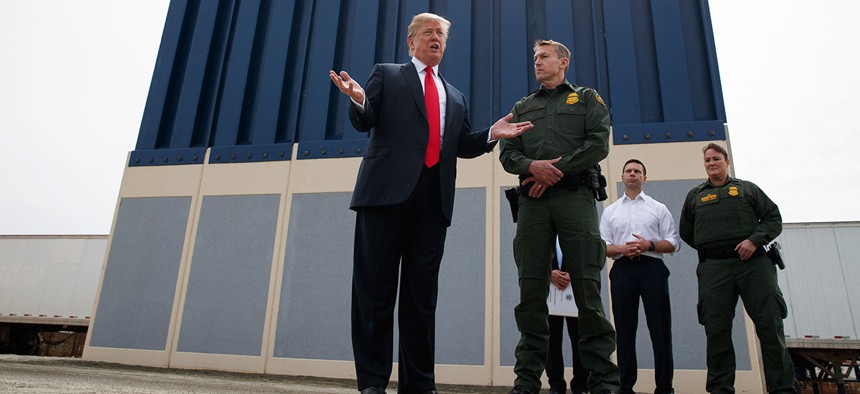
Evan Vucci/AP
What's Next for Trump's Border Wall?
This week, the president inspected eight prototypes, but his administration still has a long way to go before bringing his campaign pledge to fruition.
This week, during a visit to California, President Trump inspected eight prototypes for his proposed border wall. The president has made no secret of his intent to erect a physical barrier along the border. After touring the structures, he tweeted: “If we don’t have a wall system, we’re not going to have a country.”
But the desire to get it done doesn’t guarantee its construction. And to that end, the administration still has a long way to go before bringing the wall to fruition. Former homeland security officials told me that a project of this magnitude requires a focused White House effort, a clear plan, and funding from Congress to complete.
Last year, Trump signed an executive order instructing Customs and Border Protection to build a wall along the southern border. As a result, CBP fielded proposals from up to 450 companies across the country and by late October, the chosen contractors had finished constructing the prototypes. The structures fall under two categories—four are made of concrete, while four others are made from non-concrete materials—and all meet a list of requirements laid out by the agency, such as ensuring that designs prevent climbing and digging. They’ve since been tested by the agency.
The prototypes, which are up to 30-feet tall, towered over the president as he spoke with Border Patrol officials on Tuesday. During his visit, Trump said he favored concrete walls because they were harder to climb, but emphasized the need for it to be see-through, which is generally preferred by agents. “We have a lousy wall over here now, but at least it stops 90, 95 percent,” he said. “When we put up the real wall, we’re going to stop 99 percent. Maybe more than that.”
Today, some 650 miles are already covered by a variation of fencing. In 2006, President George W. Bush signed the Secure Fence Act, which authorized 700 miles of double-layer fencing along the southern border. The difficulty of sealing portions of the border then provides a glimpse of what still lies ahead for the Trump administration, and helps explain why the administration isn’t farther along in its goal.
As former governor of Texas, Bush was very familiar with the southern border: Texas and Mexico share nearly 1,300 miles of border. During his tenure as president, Bush expressed his desire to overhaul the nation’s immigration system, though his proposals were different from those of Trump’s, they also included measures to enhance border security. “I would suggest to members of Congress as they debate this issue that they ought to come down and take a look at the border, see what it’s really like. It requires an intense focus of resources and assets in order to secure this border. It also requires a comprehensive strategy, as well,” Bush said in May 2006 during a visit to the headquarters of the Yuma Sector Border Patrol.
The idea was the same—a barrier would prevent, or at least slow down, immigrants trying to enter the country illegally. “Looking at the border, one of the things that became evident is that there was really an insufficient amount of infrastructure at the border to control what was in some ways almost an overwhelming flood of people,” said Michael Chertoff, who served as DHS secretary from 2005 to 2009. Figures from CBP show a steady increase in border apprehensions between 2004 and 2005. The Department of Homeland Security, along with other federal agencies, worked with the White House to devise a border-security plan.
Some areas required personnel and technology to help patrol the border, particularly in areas where rough terrain would make it difficult to erect a physical barrier. The Secure Border Initiative, which DHS announced in 2005, incorporated technology, though it eventually drew criticism from the Government Accountability Office, among others, for the problems it encountered, such as only being able to identify “less than 50 percent of items of interest that cross the border,” according to a GAO report.
“It wasn’t just fencing during the Bush administration. I think people realized at the time you needed to do a multitude of things. And it wasn’t going to be one size fits all,” said James Norton, a former Bush administration official.
No project could proceed without funding, which is the key element Trump is missing in securing a path forward for his border wall. A homeland-security spending bill in 2006 allocated $1.2 billion for a fence and technology. Trump has requested $18 billion to complete a wall. His 2019 budget request includes roughly $1.6 billion to add 65 miles of walls in the Rio Grande region. Congress has so far only allocated roughly $341 million to replace some fencing and “add gates to existing barriers.” Even if lawmakers were to approve Trump’s request, that would still fall short of the up to $21.6 billion needed to seal off the entire border, as the president originally proposed.
Trump has argued that there are other avenues of funding. During the presidential campaign, he said Mexico would be responsible for the payment. And on Tuesday, he suggested that the wall would pay for itself: “It will save thousands and thousands of lives, save taxpayers hundreds of billions of dollars by reducing crime, drug flow, welfare fraud and burdens on schools and hospitals,” he said. “The wall will save hundreds of billions of dollars—many, many times what it’s going to cost.”
The Department of Homeland Security has replaced existing barriers. Within the last year, the department has exercised its authority to waive environmental laws and other regulations in a number of regions along the border. (The Bush administration also invoked this authority.) In the El Paso sector, for example, DHS is replacing vehicle barrier “with bollard wall,” according to a notice posted on the Federal Register.
Trump’s campaign pledge wasn’t to fix fencing already in place, but to mount a wall stretching the length of the entire U.S.-Mexico border. And while he may not get a wall that stretches “from sea to shining sea,” the desire to build something new still stands.
The administration has also had to prepare for the possibility of having to acquire private property, as has been done in previous years, particularly when trying to build in Texas, where much of the land on the border is privately owned. In his budget blueprint last year, Trump called for 20 additional Justice Department lawyers “to pursue federal efforts to obtain the land and holdings necessary to secure the Southwest border.” According to a DOJ official, no new cases have been filed for a new border project.
Trump’s January 2017 executive order demonstrates an administration eager to construct a new wall, but completing it will likely require more attention from the president. “This was an effort that went on for almost a year, people working 18 hours a day to crank something out to get it done. President Bush put a lot of his capital into this to try to get something done, to try to move the ball, and he himself took many meetings as well,” Norton said. “You’re just not seeing that today. It seems very whack-a-mole. Things pop here and there, but it’s not a comprehensive effort.”
In a statement, CBP said: “The President has been involved since the very beginning of the border wall development process. He provided DHS explicit guidance on what type of wall that he wants on the border—one that prevents the illegal entry of persons and contraband and one that is built as rapidly and cost effectively as possible.”
The statement continued: “To be clear, DHS does not anticipate that a single prototype design will be selected as the design standard for future border wall construction. Rather, the eight different prototypes are each anticipated to inform future border wall design standards in some capacity.”
But without funds and a clear-cut plan thereafter, construction is unlikely to make much headway.
NEXT STORY: Analysis: Telling the Truth About CIA Torture







